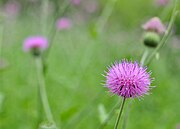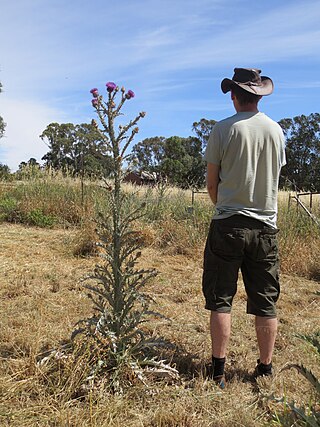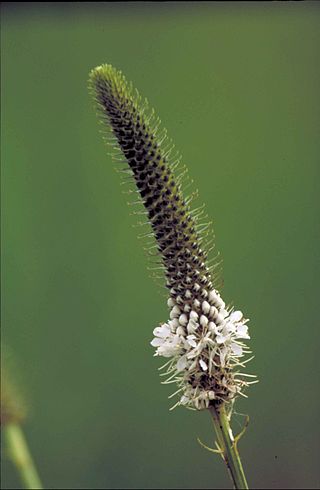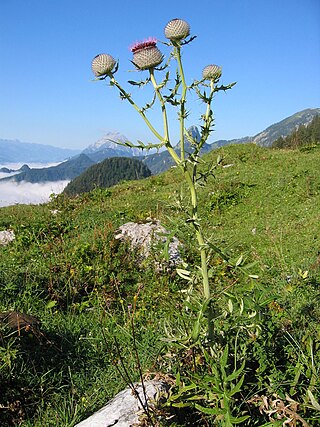- A European Goldfinch eating seeds on a Cirsium vulgare (spear thistle) seedhead
- Cirsium arizonicum (Arizona thistle)
- Cirsium canum (Queen Anne's thistle)
- Bumblebee on a Cirsium arvense (creeping thistle) flowerhead
- Cirsium vulgare (spear thistle)
- Cirsium spinosissimum (spiniest thistle)
- Cirsium pyrenaicum cut and ready to cook
- Texas purple thistle
| Cirsium | |
|---|---|
 | |
| Cirsium heterophyllum (melancholy thistle) | |
| Scientific classification | |
| Kingdom: | Plantae |
| Clade: | Tracheophytes |
| Clade: | Angiosperms |
| Clade: | Eudicots |
| Clade: | Asterids |
| Order: | Asterales |
| Family: | Asteraceae |
| Subfamily: | Carduoideae |
| Tribe: | Cardueae |
| Subtribe: | Carduinae |
| Genus: | Cirsium Mill. |
| Species [1] | |
383; see text | |
| Synonyms [1] | |
| |
Cirsium is a genus of perennial and biennial flowering plants in the Asteraceae, one of several genera known commonly as thistles. They are more precisely known as plume thistles[ citation needed ]. These differ from other thistle genera ( Carduus , Silybum and Onopordum ) in having a seed with a pappus of feathered hairs on their achenes. The other genera have a pappus of simple unbranched hairs. [2]
Contents
They are mostly native to Eurasia and northern Africa, with about 60 [3] species from North America (although several species have been introduced outside their native ranges). The lectotype species of the genus is Cirsium heterophyllum (L.) Hill. [4]
Cirsium thistles are known for their effusive flower heads, usually purple, rose or pink, also yellow or white. The radially symmetrical disc flowers are at the end of the branches and are visited by many kinds of insects, featuring a generalised pollination syndrome. [5] They have erect stems, with a characteristic enlarged base of the flower which is often spiny. The leaves are alternate, spiny in many (but not all) species, and in some species can be slightly to densely hairy. Extensions from the leaf base down the stem, called wings, can be lacking (Cirsium arvense), conspicuous (Cirsium vulgare), or inconspicuous. They can spread by seed, and also by rhizomes below the surface (Cirsium arvense). The seeds have a tuft of hair, or pappus, which can carry them far by wind.
Cirsium thistles are used as food plants by the larvae of some Lepidoptera species—see list of Lepidoptera that feed on Cirsium. The seeds are attractive to small finches such as American goldfinch.
Many species are considered weeds, typically by agricultural interests. Cirsium vulgare (spear thistle) is listed in the United States (where as a non-native invasive species it has been renamed "bull thistle") as a noxious weed in nine states. [6] Some species in particular are cultivated in gardens and wildflower plantings for their aesthetic value and/or to support pollinators such as bees and butterflies. Some species dubbed weeds by various interest groups can also provide these benefits. Cirsium vulgare, for instance, ranked in the top 10 for nectar production in a UK plants survey conducted by the AgriLand project which is supported by the UK Insect Pollinators Initiative. Cirsium vulgare was also a top producer of nectar sugar in another study in Britain, ranked third with a production per floral unit of (2323 ± 418μg). [7] Not only does it provide abundant nectar, it provides seeds for birds, such as the European goldfinch Carduelis carduelis, and supports the larvae of the Painted Lady butterfly Vanessa cardui. [8] Some other common species are Cirsium arvense , Cirsium palustre, Cirsium oleraceum .
Some ecological organizations, such as the Xerces Society, have attempted to raise awareness of the benefits of thistles, to counteract the general agricultural and home garden labeling of thistles as unwanted weeds. The monarch butterfly ( Danaus plexippus ), for instance, was highlighted as relying upon thistles such as tall thistle ( Cirsium altissimum ) as nectar sources during its migration. [9] Some prairie and wildflower seed production companies in the United States supply bulk seed of native North American thistle species for wildlife habitat restoration, although availability tends to be low. Thistles are particularly valued by bumblebees for their high nectar production.
Certain species of Cirsium, like Cirsium monspessulanum , Cirsium pyrenaicum and Cirsium vulgare , have been traditionally used as food in rural areas of southern Europe. Cirsium oleraceum is cultivated as a food source in Japan and India. Cirsium setidens is used as a vegetable in Korean cuisine.
'Cirsium' is the Greek word for thistle, kirsos, likely derived from 'swollen vein'. The flower blooms April to August.






















